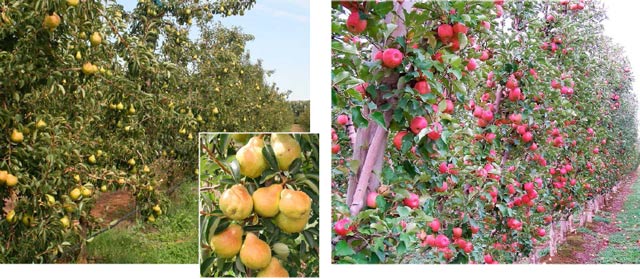The following is a summary of what you can do to minimise sunburn of fruit:
(continued from last issue)
• When fruit size exceeds 40 mm in diameter, apples become vulnerable to sunburn. It is important to protect the apples as early as mid-November because cells in the skin damaged early in the season do not recover.
• In bi-coloured and red varieties, thinning fruit down to ones and twos maximises colour development and can minimise sunburn. What seems above all to make fruit on a tree more vulnerable to sunburn, is the crop load or the leaf-to-fruit ratio.
When there are more fruit and fewer leaves, there is a lot more fruit exposed to the sun. If the fruit is covered by a few leaves at some part of the afternoon, it will most likely not burn.
• With summer pruning and leaf thinning to improve red or pink skin colour, make sure that you do not overexpose the fruit with too much leaf removal.
Try to do it when the weather forecast is for about a week of cool weather, so the fruit has time to adjust.
Watershoots should be removed throughout the growing season to maintain light penetration and allow fruit to condition. Removing watershoots several weeks before harvest exposes previously unconditioned fruit. This does not apply to the very late varieties like Pink Lady.
• Take care when you do late hand-thinning because unconditioned fruit can suddenly be exposed to the sun and intense heat, resulting in previously protected fruit becoming sunburned.
• Removal of sunburned fruit should be delayed as long as possible to minimise additional damage.
• Fruit burns less if trees are irrigated regularly. Irrigation maintains the tree’s water status and its ability to cool itself through transpiration.
• Varieties like Granny Smith, Fuji, Braeburn and Jonagold tend to burn more than Delicious, Golden Delicious or Gala. It is difficult to rate varieties for their susceptibility to sunburn because it varies so much with tree age, vigour and crop load. Young trees tend to have more sunburned fruit because the fruit is more exposed than older trees.
• Apple trees on dwarfing rootstocks such as M26 and M9, need good protection to avoid large scale sunburning of fruit.
• Sun damaged cells in the skin can be susceptible to infection by pathogens such as fungi that cause summer rots.
• Sunburn can occur in the bins during harvest, when temperatures exceed 30C. Cover the bins in the orchard to avoid overheating of the harvested fruit.
• After storage, flesh breakdown can often be observed under a sunburned spot.
• The skin which has been exposed to high temperatures is very susceptible to storage scald.
See this article in Tree Fruit Jan 2023
This article is from the Orchard Manual: UNDERSTAND FRUIT TREES




















